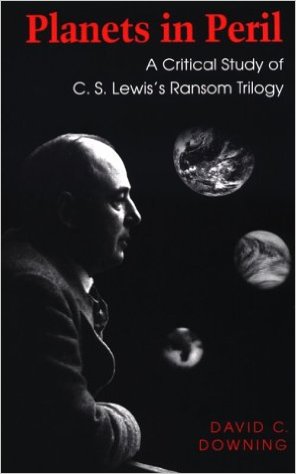Planets in Peril

David C. Downing. Planets in Peril: A Critical Study of C.S. Lewis’s Ransom Trilogy. Amhurst: University of Press, 1992, 186 pp. ISBN 0-87023-774-8. $23.95
Reviewed by Nancy-Lou Patterson
[This review originally appeared in Mythlore 20.2 (#76) (1994): 38-39.]
Certainly the best study ever of the “Ransom Trilogy,” C.S. Lewis’s breathtaking novel sequence, Out of the Silent Planet (1938), Perelandra (1943), and That Hideous Strength (1945)—and arguably one of the best books ever written about C.S. Lewis—this splendid work presents a solidly balanced, insightful, and deeply convincing analysis of Lewis’s methods and meanings. Here is a critic who takes Lewis seriously, neither as an icon nor as a target, but as an individual human being of his time, and of his life experience, whose power extends, as does that of all writers whose work have become classic, beyond that time and that life, and continues to move and to delight.
Downing’s method is simple, accurate, and effective, but it could not have been accomplished except by a scholar who is also, like Lewis, a genuine reader, familiar with the broad canon of Western literature: Dante, Spenser, de Lorris, de Meung, Swift, Blake, Morris, Chesterton, MacDonald, Tolkien, Lindsay, Williams, as well as Wells, Stapledon, Shaw, and Haldane. Lewis read these works, wrote about them in his letters and in his scholarship, and used them unabashedly as models and sources to be honored by emulation or opposed by correction, sometimes serious, sometimes comic. Lewis’s works is allusive and inclusive from his heights to his depths, layer upon layer as high or as low as you go; he never threw away a single word. His writing with its crisp, potent, elegant, deceptively simple voice, harvests and marshals the lifetime reading of one of the West’s best scholars, and weaves it anew into works that are themselves a part of that long and still powerful body of discourse.
Most of all, Downing takes Lewis seriously as a human being, as one who had been a child, a boy, a young man, an adult, an atheist, a seeker, a convert, and a convicted Christian. He composes for Lewis the beginnings of a reader’s lexicon:
Surprised by Joy illuminates the master motifs of the Ransom stories … And as seen in terms such as nurse, boy, and moonlight, it also aids in interpreting recurring images in the trilogy by giving readers a more exact sense of their emotional associations for Lewis. (33)
In this treatment, the first chapter becomes not merely the required rehearsal of an author’s biography, but a genuine key to major elements, symbols, and ideas in Lewis’s books. Each of the six succeeding chapters treats all three of the novels in terms of a particular aspect. Chapter two discusses the trilogy’s “Christian Vision” (accurately and with a precise understanding of Lewis’s specific interpretations of orthodox Western Christianity). Chapter three shows exactly how “Elements of Classicism and Medievalism” form the milieu of delight in the three books. Chapter four considers the characters whom Lewis used to embody evil, for Devine and Weston through the denizens of the N.I.C.E. Chapter five discusses the “Spiritual Pilgrimage” of Lewis himself (he was, after all, a character, named “Lewis,” in each of the novels), and of his invented characters, Ransom, Mark, and significantly, Jane. Chapter six touches upon other “Models, Influences, and Echoes,” particularly from writers and ideas contemporary with Lewis himself. Finally, the seventh chapter succeeds in “Assessing the Trilogy,” with due attention to Lewis’s alleged “attack on science,” misogyny, and inclusion of violence, concluding with a survey of excellences.
These are, tellingly, “the sense of actuality Lewis creates,” “Lewis’s evocative prose,” “Lewis’s intellectual energy and broad synthesis of ideas” (154), his “rare mythic quality,” and finally, his “vision” (155). Downing concludes that while “Lewis’s worldview rested upon a complex foundation of philosophy, theology, cultural history, and personal experience, … larger than all of this is a consistent vision” (156), a vision which this excellent study shapes and effectively sets forth. Most highly recommended!

